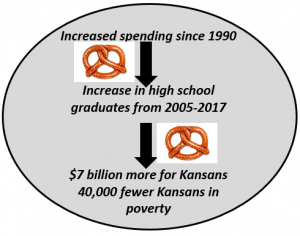The McMillan Dictionary defines pretzel logic as
Faulty or circular reasoning that does not stand up to scrutiny
That definition fits a recent Tallman Report to the proverbial T. After years and years of being in denial, Mr. Tallman finally concedes that education spending has, indeed, risen drastically in the past quarter-century.
Why the sudden change? It is to make misguided use of data to establish a (false) causal relationship between the ballooned education spending since 1990 and the recent improvement in the economy. Specifically, he claims that spending has led to “gains in Kansas education outcomes [and a] positive impact on [the] Kansas economy.”
Huh?
This appears incongruous with the reductions-in-education-funding-since-the-Great-Recession-has-damaged-public-education mantra of the past decade. That opinion has now morphed into a trumpeting of “short term” increases in the rates of high school graduation, post-secondary participation, and four-year degree completion. And we are supposed to believe those gains are a result of high education spending.
This attitudinal one-eighty is based on a misunderstanding of what constitutes a causal relationship. It is vital to note that this inference was reached by gleaning a small handful of cherry-picked U.S. Census data to conclude that increased education spending is the cause for higher education outcomes, more college graduates, higher incomes, and reduced poverty. This conclusion is totally without foundation, based only on a “sounds good” level of rigor.
 In particular is the causal connection Mr. Tallman makes between increased education spending and the so-called reduction in poverty – one not even based in fact, but in a supposition. This postulate claims “increased education levels equals a reduction of nearly 40,000 Kansans in poverty, or 18.5%.” Did that data come directly from the U.S. Census Bureau? No. It’s based on a “Hypothetical 2017 Poverty at 1990 Education Levels.” Poverty data from 1990 (and only those 25 years and older – why?) was extrapolated to 2017 based on 1990 education spending. The difference between the projected poverty levels and the actual level (40,000) is described as a function of education spending – and presented as fact.
In particular is the causal connection Mr. Tallman makes between increased education spending and the so-called reduction in poverty – one not even based in fact, but in a supposition. This postulate claims “increased education levels equals a reduction of nearly 40,000 Kansans in poverty, or 18.5%.” Did that data come directly from the U.S. Census Bureau? No. It’s based on a “Hypothetical 2017 Poverty at 1990 Education Levels.” Poverty data from 1990 (and only those 25 years and older – why?) was extrapolated to 2017 based on 1990 education spending. The difference between the projected poverty levels and the actual level (40,000) is described as a function of education spending – and presented as fact.
What is actually of import in this article is not was reported, but the elephant in the room that was neglected. I agree that the Kansas economy has improved in the short term – just like the rest of the country. Nowhere in the article is mention of the “rising tide lifts all boats” explanation for what is happening in Kansas. Kansas is simply benefiting from the long-term post-recession nationwide recovery.
So what’s the real reason for producing such an article? It’s all about the perpetual drum-beat for more government spending. The school lobby, namely KASB and their lawyers, have never met a dollar they didn’t want to spend. It is part of the tax-and-spend mentality to justify taking more money out of private hands and giving it to the public officials. In a tax-and-spend world, whatever the question the government is the only one with the right answer. And they like to keep it simple. When things are “bad,” it is because there is not enough government spending. When things are “good,” it is because of government spending – with the unspoken understanding that more is necessary to either keep it “good” or make it even “better.” This pretzel logic takes a page right out of this playbook but does little to help, or even mention, individual Kansas kids.




